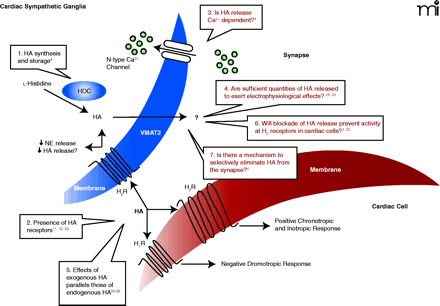
- Institution: Stanford Univ Med Ctr Lane Med Lib/Periodical Dept/Rm L109
- Sign In as Member / Individual
Histamine in Cardiac Sympathetic Ganglia: A Novel Neurotransmitter?

Does histamine meet seven distinct criteria in cardiac sympathetic ganglia that define a neurotransmitter? Histamine (HA) appears to be synthesized by histidine decarboxylase (HDC) and also stored within cardiac ganglia (1). G protein–coupled histamine receptors are present on both presynaptic cells and in the heart itself (2); however, only limited evidence suggests that histamine release may be dependent upon N-type Ca2+ channel activation (3). Whether sympathetic ganglia in the heart actively release histamine to concentrations sufficient to exert effects under physiological conditions is less clear (4), although endogenous histamine may play an important role in the modulation of cardiac function during pathological states. Pharmacological studies have suggested that the effects of endogenous histamine on cardiovascular function and the regulation of NE release are similar to that of exogenous histamine (5); however, the blockade of endogenous histamine release to abolish activity at presynaptic H3 receptors or at postsynaptic H1 and H2 receptors has not been conclusively demonstrated (6). Finally, with the exception of the possible functional absorption of histamine in the synapse by presynaptic H3 receptors or VMAT2-mediated transport, there is no known mechanism to eliminate selectively or to degrade histamine from the synaptic cleft of cardiac sympathetic ganglia (7).


